Do you have a question about the Roland GR-540 and is the answer not in the manual?
Provides instructions for machine setup and software installation.
Provides instructions for basic machine operation and maintenance.
Instructions and tips for using the machine and its software on Windows.
Instructions and tips for using the machine and its software on Macintosh.
Detailed explanation of CutStudio software functions.
Precautions for handling the precision device and installation site.
Information on liability and backup procedures for important data.
Information on obtaining support via the Roland DG Corp. website.
Information on company and product names as trademarks.
Overview of the machine's capabilities and applications.
Details on compatible material sizes and cutting dimensions.
Identification of the main unit's components.
Explanation of the carriage LED lamp status indicators.
Procedure for basic cutting operations to create stickers.
List of necessary items for cutting operations besides the main machine.
Instructions for installing and using the CutStudio software.
Information on material compatibility and specifications.
Guidance on adjusting the blade extension for optimal cutting.
Procedure for launching the CutStudio software.
Steps to configure the cutting machine model in CutStudio.
Procedure to set the material dimensions within the software.
Instructions for sending data from Adobe Illustrator.
Instructions for sending data from CorelDRAW.
Overview of the printing and cutting process for creating stickers.
Visual representation of the printing and cutting workflow.
Information on compatible materials for printing and cutting.
Procedure for printing and cutting using CutStudio.
Instructions for printing and cutting using software plug-ins.
Guidance on using Roland DG Corp. printers for combined operations.
Explanation of crop marks used for alignment in cutting.
Guidance on selecting the appropriate number of crop marks.
Details on the machine's sensor capabilities for reading crop marks.
Conditions under which Tool Mode alignment is necessary.
List of necessary tools for cutting in Tool Mode.
Procedure for loading material when using Tool Mode.
Steps to send data and perform manual alignment in Tool Mode.
Introduction to cutting material without carrier paper for various applications.
Procedure for cutting perforated lines using CutStudio.
Procedure for cutting perforated lines using Adobe Illustrator.
Procedure for cutting perforated lines using CorelDRAW.
Splitting large data into multiple sheets for cutting.
Explanation of the inner margin setting for tiled output.
Tips and settings to improve the quality of cuts on materials.
Methods to prevent and fix issues with misaligned cuts.
Procedure for setting the origin to minimize material waste.
Adjusting the force of middle pinch rollers for sensitive materials.
Instructions for periodic cleaning of the machine for optimal cutting.
Procedure for replacing the blade and separating knife.
Information on purchasing replacement parts like blades and holders.
Steps to resolve issues when the machine does not operate.
Solutions for issues related to material jams.
Troubleshooting for flat material setup when length is not displayed.
Troubleshooting for issues with creating or importing design data.
Solutions for material slipping from pinch rollers during operation.
Steps to resolve issues where crop marks are not detected.
Troubleshooting for poor cutting quality or unclean edges.
Procedures for installing and uninstalling machine software and drivers.
Answers to common questions regarding machine usage and software.
Overview of the printing and cutting process for creating stickers.
Information on compatible materials for printing and cutting.
Procedure for printing and cutting using Adobe Illustrator.
Procedure to switch from 4 crop marks to 3 crop marks in CutStudio.
Introduction to cutting material without carrier paper for various applications.
Procedure for cutting perforated lines using CutStudio.
Procedure for cutting perforated lines using Adobe Illustrator.
Procedure for cutting perforated lines using CorelDRAW.
Settings related to machine operation, language, and display.
Techniques and settings to reduce material waste during cutting.
Methods for achieving cleaner cuts, especially for detailed shapes.
Adjusting settings for different material thicknesses and hardness.
Strategies for preventing and fixing misaligned cuts.
Steps to resolve issues where crop marks are not detected.
Troubleshooting for poor cutting quality or unclean edges.
Answers to common questions regarding machine usage and software.
Provides instructions for machine setup and software installation.
Provides instructions for basic machine operation and maintenance.
Instructions and tips for using the machine and its software on Windows.
Instructions and tips for using the machine and its software on Macintosh.
Detailed explanation of CutStudio software functions.
Precautions for handling the precision device and installation site.
Information on liability and backup procedures for important data.
Information on obtaining support via the Roland DG Corp. website.
Information on company and product names as trademarks.
Overview of the machine's capabilities and applications.
Details on compatible material sizes and cutting dimensions.
Identification of the main unit's components.
Explanation of the carriage LED lamp status indicators.
Procedure for basic cutting operations to create stickers.
List of necessary items for cutting operations besides the main machine.
Instructions for installing and using the CutStudio software.
Information on material compatibility and specifications.
Guidance on adjusting the blade extension for optimal cutting.
Procedure for launching the CutStudio software.
Steps to configure the cutting machine model in CutStudio.
Procedure to set the material dimensions within the software.
Instructions for sending data from Adobe Illustrator.
Instructions for sending data from CorelDRAW.
Overview of the printing and cutting process for creating stickers.
Visual representation of the printing and cutting workflow.
Information on compatible materials for printing and cutting.
Procedure for printing and cutting using CutStudio.
Instructions for printing and cutting using software plug-ins.
Guidance on using Roland DG Corp. printers for combined operations.
Explanation of crop marks used for alignment in cutting.
Guidance on selecting the appropriate number of crop marks.
Details on the machine's sensor capabilities for reading crop marks.
Conditions under which Tool Mode alignment is necessary.
List of necessary tools for cutting in Tool Mode.
Procedure for loading material when using Tool Mode.
Steps to send data and perform manual alignment in Tool Mode.
Introduction to cutting material without carrier paper for various applications.
Procedure for cutting perforated lines using CutStudio.
Procedure for cutting perforated lines using Adobe Illustrator.
Procedure for cutting perforated lines using CorelDRAW.
Splitting large data into multiple sheets for cutting.
Explanation of the inner margin setting for tiled output.
Tips and settings to improve the quality of cuts on materials.
Methods to prevent and fix issues with misaligned cuts.
Procedure for setting the origin to minimize material waste.
Adjusting the force of middle pinch rollers for sensitive materials.
Instructions for periodic cleaning of the machine for optimal cutting.
Procedure for replacing the blade and separating knife.
Information on purchasing replacement parts like blades and holders.
Steps to resolve issues when the machine does not operate.
Solutions for issues related to material jams.
Troubleshooting for flat material setup when length is not displayed.
Troubleshooting for issues with creating or importing design data.
Solutions for material slipping from pinch rollers during operation.
Steps to resolve issues where crop marks are not detected.
Troubleshooting for poor cutting quality or unclean edges.
Procedures for installing and uninstalling machine software and drivers.
Answers to common questions regarding machine usage and software.
Overview of the printing and cutting process for creating stickers.
Information on compatible materials for printing and cutting.
Procedure for printing and cutting using Adobe Illustrator.
Procedure to switch from 4 crop marks to 3 crop marks in CutStudio.
Introduction to cutting material without carrier paper for various applications.
Procedure for cutting perforated lines using CutStudio.
Procedure for cutting perforated lines using Adobe Illustrator.
Procedure for cutting perforated lines using CorelDRAW.
Settings related to machine operation, language, and display.
Techniques and settings to reduce material waste during cutting.
Methods for achieving cleaner cuts, especially for detailed shapes.
Adjusting settings for different material thicknesses and hardness.
Strategies for preventing and fixing misaligned cuts.
Steps to resolve issues where crop marks are not detected.
Troubleshooting for poor cutting quality or unclean edges.
Answers to common questions regarding machine usage and software.
| Max Media Width | 610 mm |
|---|---|
| Supported OS | Windows, Mac |
| Power Supply | AC 100-240V, 50/60Hz |
| Blade Holder | Standard |
| Interface | USB |
| Cutting Width | 540 mm |
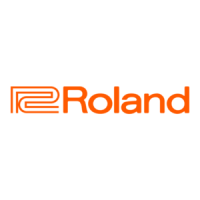


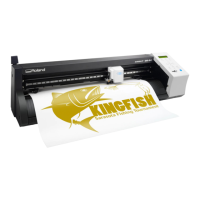
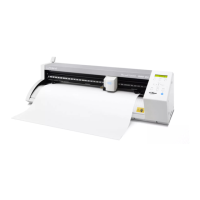



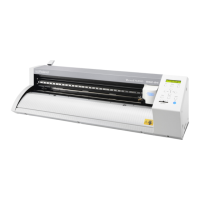
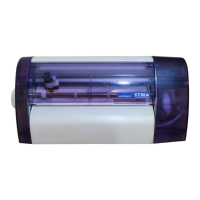

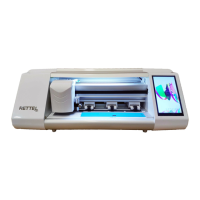
